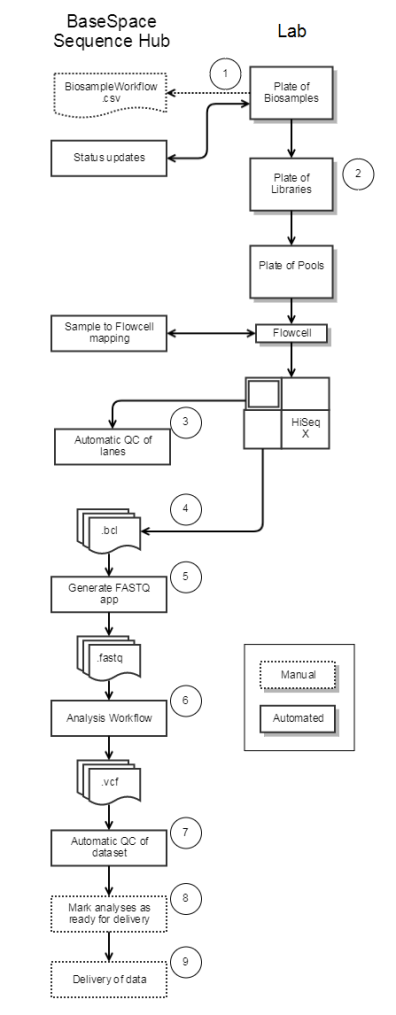Automatic Data Flow
The following diagram illustrates the data flow and automation steps in BaseSpace Sequence Hub.

- Biosample Workflow File Import—Add biosamples, library prep instructions, and analysis workflow instructions via a biosample workflow file. BaseSpace Sequence Hub creates new biosamples and schedules analyses.
After validating the manifest, BaseSpace Sequence Hub creates a new biosample and associated library prep requirements, and schedules a new analysis which includes analysis QC thresholds and a yield dependency. - Library Prep—BaseSpace Sequence Hub reports library prep status and QC.
- Automatic Lane QC—BaseSpace Sequence Hub automatically performs lane QC on the new sequencing data based on the configured lane QC thresholds.
- Streaming Sequencing Data—The lab loads a flow cell and starts sequencing. Sequencing data begins to arrive in BaseSpace Sequence Hub.
- Automatic FASTQ Dataset Generation—BaseSpace Sequence Hub performs demultiplexing, if needed, and generates FASTQ data sets for each library by lane and index (if indexing). QC-passed files are added to the yield calculations for the biosample.
- Automatic App Launch—BaseSpace Sequence Hub automatically launches pending analyses that have yield dependencies met with the new data.
BaseSpace Sequence Hub aggregates all FASTQ data sets for a biosample as inputs to the analysis, excluding biosamples that are QC failed or are associated with a different project. Data sets can originate from multiple flow cells or other uploads. - Automatic Analysis QC— BaseSpace Sequence Hub automatically performs analysis QC after analysis is complete.
- Mark Analyses for Delivery—BaseSpace Sequence Hub users manually review analyses and change the status of acceptable analyses as Ready For Delivery.
- Deliver Data—Deliver data using your preferred delivery mechanism, and mark the data as delivered.